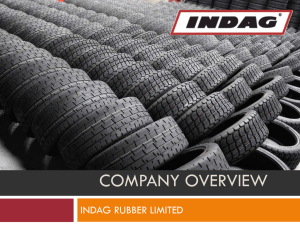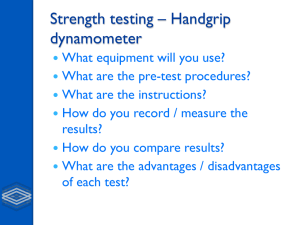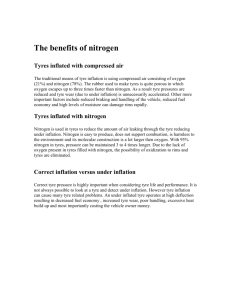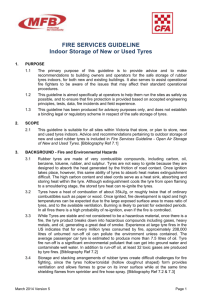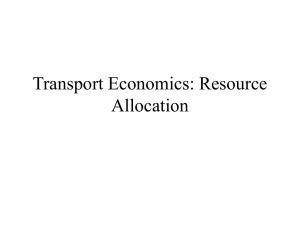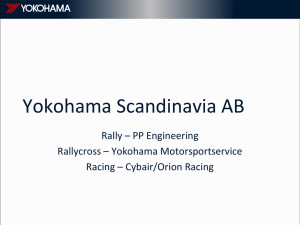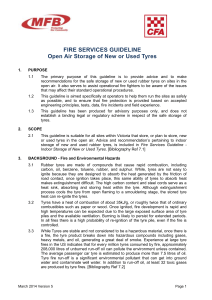Tyre Labelling (EC/1222/2009)
advertisement
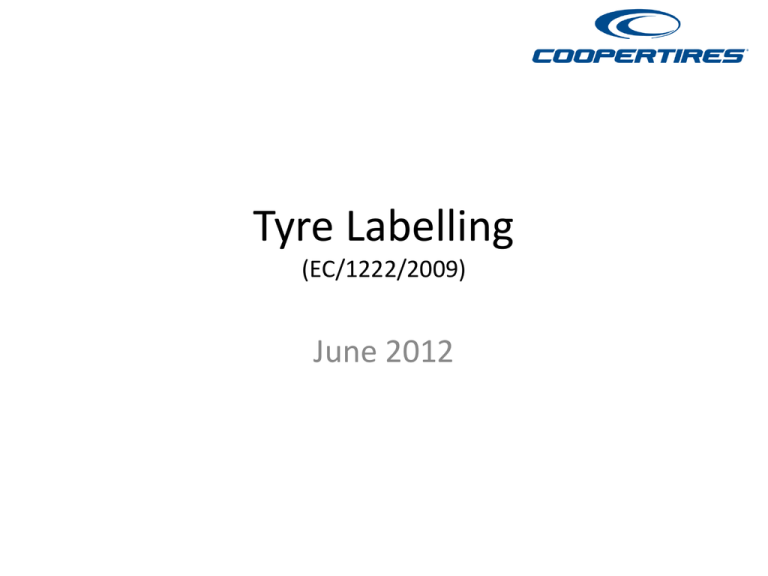
Tyre Labelling (EC/1222/2009) June 2012 Tyre Labelling • Tyres will be graded according to wet grip, fuel efficiency and external noise. • The presentation will be based on the familiar EU energy efficiency label. Note for car, 4x4 and van tyres: class D is not used so there are only 6 classes for Fuel efficiency. In addition, for Wet grip class G is also not used so there are only 5 classes for Wet grip. Sample label What does the label mean? FUEL EFFICIENCY (Rolling Resistance) 7.5% loss of fuel economy between best and worst class (average) WET GRIP (Braking Performance) 30% shorter braking distance between best and worst class (average) Effect may vary among vehicles and driving conditions, but in the case of full braking, the difference between a G and an A class for a set of four identical tyres could be up to 30% shorter braking distance (e.g. for a typical passenger car driving at 80 km/h speed this could be up to 18m shorter braking distance). NOISE (Exterior Rolling Noise – not cabin noise) Measured in decibels 3 black bars: above future EU limit, complies with current S Mark 2 black bars: meets future EU limit 1 black bar: at least 3 dB below the future EU limit When does the Regulation come into force? • Manufacturers and importers will have to provide information regarding the performance of tyres they supply in the EU that were manufactured from 1st July 2012. • From 1st November 2012 retailers in the EU will have to provide consumers with information regarding the performance of tyres offered for sale that were manufactured from 1st July 2012. (Date of production code 2712 or greater). What about tyres manufactured before 1st July 2012? • Operators throughout the supply chain will have to manage a transition period while stocks contain tyres made both before and after 1st July 2012. • Some manufacturers or importers may choose to label tyres made before 1st July 2012 but the Regulation does not require them to do so. • We will not carry out retrospective labelling of tyres already in the supply chain that were made before 1st July 2012 Other factors to consider The new EU labels show wet grip (stopping distance in a straight line), exterior noise and fuel efficiency data only. What else is important? • Dry handling • Dry grip (straight line) • Dry grip (circles/cornering) • Wet handling • Wet grip (circles/cornering) • Resistance to aquaplaning (straight/curved) • High-speed stability • Interior noise • Tread wear Not on label Not on label Not on label Not on label Not on label Not on label Not on label Not on label Not on label Factors determining tyre performances 10% 20% Dry handling 20% Wet braking 12% Wet handling Exterior noise Interior noise 5% Wear 5% Fuel efficiency 28% ADAC test criteria percentages Factors determining tyre performances Fuel efficiency, 10% Dry handling , 20% Wear, 20% Wet braking, 12% Interior noise, 5% Exterior noise, 5% Wet handling, 28% ADAC test criteria percentages Other factors to consider Actual fuel savings and road safety depend heavily on the behaviour of drivers: - eco-driving can significantly reduce fuel consumption - tyre pressures should be regularly checked to optimise wet grip and fuel efficiency performance - stopping distances should always be strictly respected Talking points • The new label does not address every factor which is critical to overall tyre performance • Other important criteria include but are not limited to: – – – – – – Dynamic handling in wet and dry Dry braking performance Resistance to straight and curved line aquaplaning High speed performance Stability Wear versus cost (value for money) • The following spider graphs demonstrate Cooper and Avon products’ performance against competition in some of these other areas Talking points • • • • As an EU replacement market manufacturer our emphasis has been on maintaining Wet Grip and Wear performance whilst being mindful of the environmental benefits of lower Rolling Resistance tyres Dynamic Handling Properties in wet and dry conditions have been a major consideration in the development of our products To meet vehicle manufacturers’ environmental requirements OE tyre manufacturers have had to focus on Rolling Resistance. This could be at the expense of other factors such as wear It’s important to remember that the benefits of low Rolling Resistance tyres can be adversely affected by under inflation Avon ZZ5 vs competition Avon ZV5 vs competition Cooper CS6 vs competition Cooper WM-SA2 vs competition



